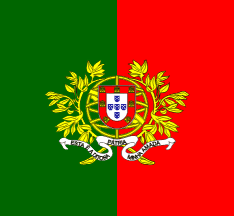António Martins, 03 Feb 1998

Last modified: 2015-02-14 by klaus-michael schneider
Keywords: military | esta é a ditosa pátria minha amada | coat of arms: escutcheons |
Links: FOTW homepage |
search |
disclaimer and copyright |
write us |
mirrors

The portuguese military flag (Smith’s dot in grid
![]() )
is 12:13 and has a more complicated coat of arms
than the national flag (sphere, shield, laurel wreath
around it and scroll with motto "ESTA É A DITOSA PÁTRIA
MINHA AMADA"). The official measures are: 120×130 flag,
armillary sphere diameter 40 (source:
[cba11]).
)
is 12:13 and has a more complicated coat of arms
than the national flag (sphere, shield, laurel wreath
around it and scroll with motto "ESTA É A DITOSA PÁTRIA
MINHA AMADA"). The official measures are: 120×130 flag,
armillary sphere diameter 40 (source:
[cba11]).
António Martins, 03 Feb 1998
According to [sjcXX],
the National Standard (that is, a colour) is the national flag,
and is carried by those (Army) units entitled to one.
The national flag when used as a colour is 1.25 m square, with
cords and tassels in red, green and gold. The staff bears the unit
name or abbreviation engraved on the staff, just below the lance
head finial.
Ian Sumner, 19 Dec 2003
I believe the version of the Portuguese flag used as a military
unit color is trimmed with gold fringe.
Joe McMillan, 26 Feb 2003
It seems that regiments and other divisions of the portuguese military
forces, particularly the army, have flags consisting
of banners of the respective arms.
According to TV footage where I’ve seen on several occasions this kind of
flag in military ceremonies, the flags are either square or follow the same
dimensions of the portuguese military standard: 10:11.
I think they are really square.
Joe McMillan, 15 Dec 2003
If not law, then at least tradition requires that each unit in portuguese
secutiry forces (including the military and the police forces) has its own
set of symbols.
Jorge Candeias, 16 May 2004
I’ve seen pictures of what could be called “heraldic
standards” for Portuguese military units, but usually with a geometric
background with either the shield or some charge from the arms on the center,
rather than an actual banner of the unit arms. The website of the Portugues
military college calls such a flag a guião. See
www.aaacm.pt/colegiomilitar/guiao.htm.
Other Portuguese military unit web pages refer to — without depicting —
guiões of brigades, regiments, battalions, etc. Are these,
guião and estandarte heráldico, the same thing?
Joe McMillan, 16 Dec 2003
I’ve seen both kinds of flags (guiões and simple
banners-of-the-arms) and never understood the difference between the two,
or when one or the other is used. Guiões are always flags with
borders, usually containing squares in the corners and often with crosses
in the main field. [Ex.: Airforce Academy
vs. B.M.I.]
Jorge Candeias, 16 Dec 2003
An ICHG article by José de Campos e Sousa [sjcXX] says:
"Distinctive" symbols are shields which may have party fields or fields with charges.
"Distinctive and merit" symbols of units are similar, but have the helmet turned fully toward the dexter. "Distinctive and merit" shields for Arms and Services, for the use of the general in command, consist of the unit or formation badge superimposed on the badge of the Arm or Service. "Distinctive and merit" symbols for commanders of military regions and the equivalent (Quater-Master General, Inspector-General, and Vice Chief of Army Staff) can include arms with supporters or military trophies, or arms superimposed on badges of command.
"Merit" symbols include the cross of an Order placed behind the unit arms, or the collar of the Order placed around the shield.
Ian Sumner, 19 Dec 2003
This seems to be a rule in portuguese military heraldry: the
crest in the arms of a given subentity always (or at least usually)
includes the shield of the entity that subentity is a part of.
[Ex.: B.M.I.’ Golf group
vs. B.M.I.]
Jorge Candeias, 15 Dec 2003
Anything below this line was not added by the editor of this page.